Mary Anne Yarde's Blog: The Coffee Pot Book Club , page 143
April 16, 2019
Join #HistoricalFiction author, Peter Baggott, and find out what inspired him to write The Civilis Saga #AncientRome @baggott_scot
An author’s Inspirationsby Peter Baggott

What inspired me to write?
My sister suggested I had a flair for writing, and my wife was worried I wouldn’t cope with retirement after the Police Service.
What made me chose a historical subject?
I am not an academic, but I have always had an interest in history and particularly all things Roman. I was born in Lincoln formally the Roman location of Lindvm/Lindvm Colognia.As a teenager I worked as a paperboy amongst the remains of the Roman fort, the Medieval castle and Cathedral. I also worked part-time at a hotel which had Roman remains in the car park, and on request, I gave self-guided tours of the Roman Lincoln to predominantly American guests.
Was the Civilis Saga my first attempt at writing?
No, it wasn’t. I started writing a Greek story based around the survivors of the Trojan War being shipwrecked on Crete, an island I’ve visited many times. I couldn’t get into the story, so I turned my attention to a Roman based novel. Initially I composed a huge novel with Marcus looking back over his life. As a result of having my transcript professionally assessed I adopted her suggestions by braking the novel down into a continuous story and expanded the characters.
Did my working life help in the creation of the story?
Yes, I’ve spent three quarters of my working life in uniform, the Army, Prison Service and finally the Police. As part of the training we used riot techniques involving shields and Roman named techniques like Testudo (turtle), wedge and trudge steps. The Army and the Police taught me camaraderie and the dependence on those around you. I was promoted at nineteen the youngest ever at the time in the Artillery. At twenty-one I supervised the Regiments Medical Centre catering for over three thousand soldiers and their families including US attached soldiers and families. I enjoyed working with US soldiers and their families who were coping with tours in Vietnam, physical and mental scars. Though I didn’t take part in Northern Ireland I lost friends from my training days including my best friend who committed suicide as a result of his experiences. Having dealt with my own PTSD problem I am convinced that Roman soldiers would have suffered the same problems, despite current objectors to the idea. They were not superhuman and I would site the Vietnam War as being on a par with Roman campaigns for the battle intensity. Even to the point to which US soldiers were tortured, I have tried to give my characters human feelings and emotions, not the Hollywood heroes.
What inspired the characters and incidents in the creation of the story?
I was brought up near the Broads which are very dangerous, and I spent a lot of time there, coupled with local lakes resulting in a few unintentional dips. The proximity of water led to a friend nearly drowning (Marcus’ river incident). We all do stupid things that luckily, we survive and can reflect on, I know I have. I was a naïve eighteen-year-old when I was posted to Germany, where my friends went to great lengths to point out prostitution (the oldest job in the world it has been claimed). A German survey at the time highlighted large numbers of English women victims of domestic violence that were involved in Germany’s sex industry. Thousands of Roman soldiers never returned home, leaving starving families which prompted my inclusion of prostitution as a means of their survival. Famous pornographic mosaics found in Roman locations (Pompei being of note) offered itself as part of everyday survival. Many more had no choice – male and female slaves. I believe those on the lowest social scale would have lived a grubby squalid life style, you did what you had to, too survive.The heavy Roman losses also prompted the thoughts of fatherless children and the illegitimate they left behind - the American occupation of Vietnam, “the lost children,” (Miss Saigon).
Mysticism?
I knew an old lady in Lincoln from my paperboy days whose house bordered on the Newport Arch, a complete Roman gateway in Lincoln who told me of the “Newport Marchers.” It was suggested that the 9thHispania, a legion based in Lindvm (the legion disappeared and is still unaccounted for, however recent written accounts at Vindolanda may finally suggest they were wiped out in an uprising somewhere around AD 100+. The “ghosts” were allegedly the 9th on the way to their destruction and the little old lady insisted that on one day a year you could hear them march through the archway. I never had the opportunity to experience the phenomena, but it sparked an interest in me but sadly, due the numerous car collisions with the archway it to the erection of lighting after which the “Marchers” never reappeared. My first wife is a 3rd generation descendent of an American Indian medicine woman and claimed to see things. Many will scoff at this suggestion, but one example involved saving a young boys life from what she saw – a brain tumour. Doctors had failed to detect it and it nearly cost him his life. I have met others with the gift, and I have myself at times felt and seen things. I read somewhere, a long time ago, that we all possess(ed) a sixth sense but only a chosen few retain it.
Does my writing involve a lot of research?
Yes, I thought I had a fair knowledge of Roman history, sadly that was not so. I like to get things as accurate as I can, often incorporating new finds (the name on a Roman tombstone in York.I had a location in Dublin Bay in mind for a character’s origin, I established the site of an ancient settlement, but I needed invaders, the Vikings were much later. After extensive research, I found a marauding Welsh tribe seeking a new home who eventually settled in Ireland. The character names used are as authentic as the internet allows. I used Google maps to estimate the marching distances and then adjusted the routes to allow for physical features and any remaining Roman roads. I converted the distances to Roman miles and estimated the distances covered by a horse traveling at various speeds and the average walking day of a Roman soldier, twenty miles, to establish realistic traveling times. Most recently I have been calculating tides and currents through the English Chanel along with the different starting points of the Roman invasion of Britannia. I cannot accept that a massive fleet arrived at the same location, at the same time, with the reported historical weather conditions. My own creation of the truth or not? Why use real life people and events?
The real facts and people are the bones of which my story is the meat.
What drives to continue writing?
Readers asking for more.
What authors have inspired you to write?
My favourite historical writer is Valerio Massimo Manfredi – he’s Italian, a lecturer in Roman history and a fantastic writer. Robert Fabbri’s Vespasian series is excellent and the Angus Macdonald series about Robin Hood (Loxley?), love folklore.
The Civilis Saga is a Roman-based story of revenge encompassing drama, murder, passion, love, family relationships, political intrigue, war, mystery and mild erotica based around real-time people and events.
Part 1 Victus

VICTUS Claudian is ostracized for being a bully and a rake despite being a good soldier. His father's death leads to an opportunity within the Praetorian guard and with Sejanus as his mentor he is involved in a conspiracy to grab the purple in Rome AD 32 Whilst mentoring his sister, he establishes she has a lover and he turns his attention to find and kill that lover - a member of the Civilis family.
Amazon UK • Amazon US • Amazon CA
Part 2
ILONA Wolf Queen

Ilona is the only child of the seer Rosevetha who has foretold of a man who will enter her daughter’s life and change it forever, if he survives. Following the demise of Sejanus, Artorius Civilis is sent back to his legion in Germania to weed out other conspirators with the offer of joining the Praetorian Guard on his return. A snow storm leads him to a chance encounter containing Ilona and her mother. He is warned that he must return to Rome at the earliest opportunity but not told why. As he continues his journey north he is ambushed and left to freeze as a wold pack senses prey.
Amazon UK • Amazon US • Amazon CA
Part 3 Cay Rosevetha’s Curse
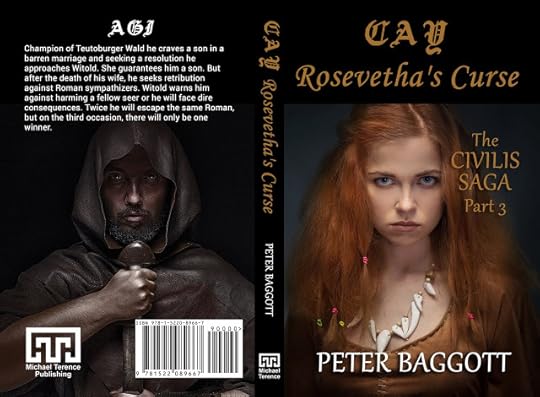
The story opens to find a young Artorius Civilis returning from Spain following the mutiny on the Rhine to find he is involved in the search for the lost Teutoberg Eagles. He returns empty-handed to both deep sorrow and jubilation and for his bravery he is offered the chance to return home and recruit replacements for the legion’s losses. Early days for Victus creates the creature he later becomes.
Amazon UK • Amazon US • Amazon CA
Peter Baggott
 Peter Baggott is a debut author with a deep interest in Roman history. He has served in three uniformed employments and is very familiar with Roman tactics which are still used in everyday life: shield tactics and skills – testudo being much used in the Police and Prison Service.
Peter Baggott is a debut author with a deep interest in Roman history. He has served in three uniformed employments and is very familiar with Roman tactics which are still used in everyday life: shield tactics and skills – testudo being much used in the Police and Prison Service.Peter chose for his writing this historical genre because of his innate interest in the subject and having been born in the Roman city of Lindvm, modern day Lincoln.
In his teens, on a daily basis, while delivering newspapers, Peter traversed the exposed Roman remains from The Steep to the Newport Arch, the only full Roman archway in Great Britain.
While working in a local hotel close to the ruins he utilised this knowledge to become a self-appointed guide to visitors from far and wide and has continued to keep up to date with local finds. There are many stories surrounding the infamous Legio IX Hispana, who were based in Lindvm, their disappearance has inspired his continuing interest in all things Roman.
Peter has also visited numerous Roman sites, both in the UK and in Europe and has used original Roman historical sources of Tacitus, Suetonius and Dio, Google Maps for distancing and location, Wikipedia and several archaeological online sources. Thus, he tries to keep abreast with new finds upgrading his work accordingly.
Connect with Peter: Website • Twitter
Published on April 16, 2019 23:00
Historical Fiction author, Mollie Walton, is talking about what inspired her to write her fabulous new book — The Daughters of Ironbridge #HistoricalFiction #NewRelease #FamilySaga @rebeccamascull
A view from the iron bridgeBy Mollie Walton
In the summer of 2016, I took my daughter to visit my brother and his wife in Shropshire. I’d never been to the county and knew nothing about it. All I remembered was an old friend of mine from university days saying she’d been to Ironbridge, how it was the first iron bridge ever built and that the area was the cradle of the industrial revolution. She also said it was beautiful there. I recalled thinking, how can something be industrial and beautiful? We arrived in Ironbridge and took a walk up to its main attraction, the glorious iron bridge itself, spanning the River Severn. We walked to the centre of the bridge and I looked down through the iron bars at the slow-moving river below. And then it happened.
 The Iron Bridge
The Iron Bridge The view of the River Severn from the Iron Bridge.
The view of the River Severn from the Iron Bridge.It’s what I like to call the “history shivers”. This isn’t a phrase I created, but I’ve heard writers and history enthusiasts use it when you experience something that really takes you back to a past age. I felt it when I saw the Bronte sisters’ writing table at their home in Haworth. And I felt it that day standing on the iron bridge. I suddenly had a vision of how the river must have looked two hundred years before, flanked by all manner of burning, smoking industry, fed by the workers and masters who fuelled it, sending goods out into the rest of the world along the river and roads, the canals and railways. All that was gone now, but the remnants remained, overgrown by the beauty of nature. My friend had been right. Just weeks before, my literary agent Laura had brilliantly suggested a brand new idea to me: writing a saga trilogy. She wanted me to come up with an idea for a story – families, industry, a beautiful yet industrial setting, conflict and drama. Standing on the bridge, I knew this was the place. Looking at both sides of the river, I realised I had my two families, one poor workers, the other rich masters. I had my setting, my characters, my conflict and drama all built in, just by gazing down from the bridge. I was itching to start writing! We visited some of the many museums of the area and everything I looked at took on a new meaning: this was where my two families lived and worked; this is what they ate and how they dressed and where they travelled to and so on. I took dozens of photos, bought a lot of books and postcards and started filling a notebook with ideas. The two families sprang almost fully formed into my head: the masters lived in a house on the top of the hill, looking down on everybody below. The workers lived in the ramshackle cottages that grew along the river when industry took hold. When I got home, I sketched out a family tree, then by researching common names of Shropshire I was able to fill in the blanks. I had my Woodvines and my Kings, my two daughters, their secret friendship and the troubles that awaited them. I planned out their lives over forty years, over three generations and three books, all mysteriously linked by a baby found on the bridge…
 Riverside Houses.
Riverside Houses. Flowers bloom on the riverside.
Flowers bloom on the riverside.I went back to the area several times, visiting other important sites, such as the ruins of the Bedlam Furnaces, the Coalbrookdale Museum of Iron and the Dana, otherwise known as Shrewsbury Prison.
 Bedlam Furnace.
Bedlam Furnace.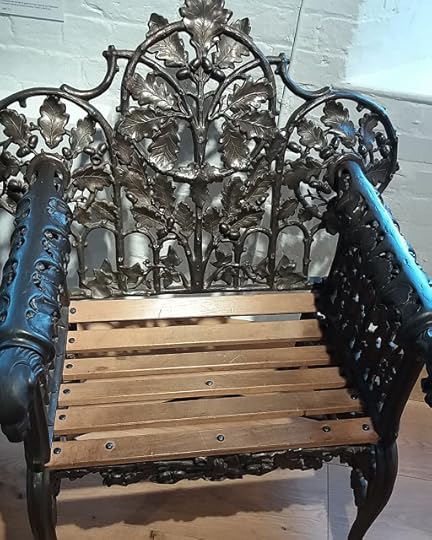 Iron Chair.
Iron Chair.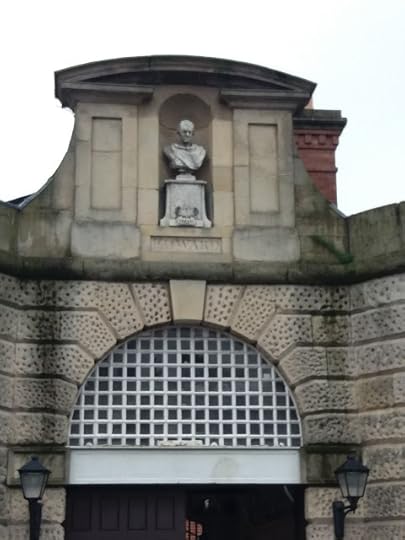 Shrewsbury Prison.
Shrewsbury Prison.I fell in love with the area and with my characters, Anny and Margaret. My agent was delighted with the whole project too. When my publisher Bonnier took on the project, I found my editor Tara, who loved these girls and their story as much as I did. We talked about them always as if they were real people! We cared deeply what happened to them: we felt bad when we put them through hard times and cheered them on when they battled against adversity. Such is the stuff of saga! I hope you love them as much as we do.
The Daughters of Ironbridge
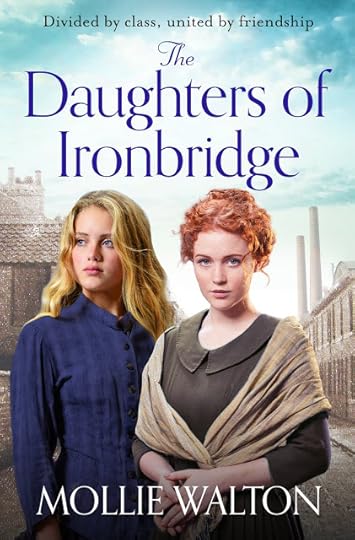 1830s Shropshire.
1830s Shropshire.Anny Woodvine's family has worked at the ironworks for as long as she can remember. The brightest child in her road and the first in her family to learn to read, Anny has big dreams. So, when she is asked to run messages for the King family, she grabs the opportunity with both hands.
Margaret King is surrounded by privilege and wealth. But behind closed doors, nothing is what it seems. When Anny arrives, Margaret finds her first ally and friend. Together they plan to change their lives.
But as disaster looms over the ironworks, Margaret and Anny find themselves surrounded by secrets and betrayal. Can they hold true to each other and overcome their fate? Or are they destined to repeat the mistakes of the past?
'The Daughters of Ironbridge has that compulsive, page-turning quality, irresistible characters the reader gets hugely invested in, and Walton has created a brilliantly alive, vivid and breathing world in Ironbridge' Louisa Treger
Amazon• Kobo• Waterstones
Mollie Walton
 Mollie Walton is the saga pen-name for historical novelist Rebecca Mascull.
Mollie Walton is the saga pen-name for historical novelist Rebecca Mascull.She has always been fascinated by history and on a trip to Shropshire, while gazing down from the iron bridge, found the inspiration for what has become her debut saga novel, part of a trilogy titled THE IRONBRIDGE SAGA, published by Bonnier Zaffre. She is currently hard at work on the three books, with the first novel due for release in April 2019, set in the dangerous world of the iron industry: THE DAUGHTERS OF IRONBRIDGE.
Under the pen-name Rebecca Mascull, she is the author of three historical novels: THE VISITORS (2014); SONG OF THE SEA MAID(2015) & THE WILD AIR (2017), all published by Hodder & Stoughton.
She has also recently completed the final chapters of her friend and fellow novelist Vanessa Lafaye's last work, the novella MISS MARLEY (2018), a prequel to Dickens's A CHRISTMAS CAROL, published by HarperCollins.
Mollie has previously worked in education, has a Masters in Writing and lives by the sea in the east of England.Connect with Mollie Walton: Website • Facebook.Connect with Rebecca Mascull: Website • Facebook • Twitter • Instagram • Pinterest.
<!-- /* Font Definitions */ @font-face {font-family:"Cambria Math"; panose-1:2 4 5 3 5 4 6 3 2 4; mso-font-charset:0; mso-generic-font-family:roman; mso-font-pitch:variable; mso-font-signature:-536870145 1107305727 0 0 415 0;} @font-face {font-family:Calibri; panose-1:2 15 5 2 2 2 4 3 2 4; mso-font-charset:0; mso-generic-font-family:swiss; mso-font-pitch:variable; mso-font-signature:-536859905 -1073732485 9 0 511 0;} @font-face {font-family:Garamond; panose-1:2 2 4 4 3 3 1 1 8 3; mso-font-charset:0; mso-generic-font-family:roman; mso-font-pitch:variable; mso-font-signature:647 0 0 0 159 0;} /* Style Definitions */ p.MsoNormal, li.MsoNormal, div.MsoNormal {mso-style-unhide:no; mso-style-qformat:yes; mso-style-parent:""; margin-top:0cm; margin-right:0cm; margin-bottom:8.0pt; margin-left:0cm; line-height:107%; mso-pagination:widow-orphan; font-size:11.0pt; font-family:"Calibri",sans-serif; mso-ascii-font-family:Calibri; mso-ascii-theme-font:minor-latin; mso-fareast-font-family:Calibri; mso-fareast-theme-font:minor-latin; mso-hansi-font-family:Calibri; mso-hansi-theme-font:minor-latin; mso-bidi-font-family:"Times New Roman"; mso-bidi-theme-font:minor-bidi;} a:link, span.MsoHyperlink {mso-style-priority:99; color:#0563C1; mso-themecolor:hyperlink; text-decoration:underline; text-underline:single;} a:visited, span.MsoHyperlinkFollowed {mso-style-noshow:yes; mso-style-priority:99; color:#954F72; mso-themecolor:followedhyperlink; text-decoration:underline; text-underline:single;} .MsoChpDefault {mso-style-type:export-only; mso-default-props:yes; font-size:11.0pt; mso-ansi-font-size:11.0pt; mso-bidi-font-size:11.0pt; font-family:"Calibri",sans-serif; mso-ascii-font-family:Calibri; mso-ascii-theme-font:minor-latin; mso-fareast-font-family:Calibri; mso-fareast-theme-font:minor-latin; mso-hansi-font-family:Calibri; mso-hansi-theme-font:minor-latin; mso-bidi-font-family:"Times New Roman"; mso-bidi-theme-font:minor-bidi;} .MsoPapDefault {mso-style-type:export-only; margin-bottom:8.0pt; line-height:107%;} @page WordSection1 {size:612.0pt 792.0pt; margin:72.0pt 72.0pt 72.0pt 72.0pt; mso-header-margin:36.0pt; mso-footer-margin:36.0pt; mso-paper-source:0;} div.WordSection1 {page:WordSection1;} </style> -->
Published on April 16, 2019 22:30
#BookReview — Arthur Dux Bellorum (A Light in the Dark Ages Book 4) by Tim Walker #Arthurian #HistoricalFiction @timwalker1666
 Arthur Dux Bellorum(A Light in the Dark Ages Book 4)By Tim Walker
Arthur Dux Bellorum(A Light in the Dark Ages Book 4)By Tim Walker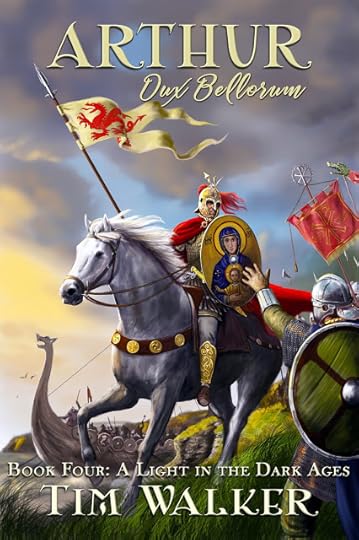
From the ruins of post-Roman Britain, a warrior arises to unite a troubled land.
Britain in the late Fifth Century is a troubled place – riven with tribal infighting and beset by invaders in search of plunder and settlement. King Uther is dead, and his daughter, Morgana, seizes the crown for her infant son, Mordred. Merlyn’s attempt to present Arthur as the true son and heir of Uther is scorned, and the bewildered teenager finds himself in prison. Here our story begins…
Arthur finds friends in unexpected quarters and together they flee. Travelling through a fractured landscape of tribal conflict and suspicion, they attempt to stay one step ahead of their pursuers, whilst keeping a wary eye on Saxon invaders menacing the shoreline. Arthur’s reputation as a fearsome warrior grows as he learns the harsh lessons needed to survive and acquire the skills of a dux bellorum, a lord of war.
Tim Walker’s Arthur Dux Bellorum is a fresh look at the Arthurian legend, combining myth, history and gripping battle scenes. Although in a series, it can be read as a standalone novel.

“We live in dangerous times…”
When King Uther Pendragon died, his daughter, Morgana, placed her son upon the throne. However, Mordred is just a child, and therefore it is Morgana that rules the kingdom, and she will quash her enemies, even if they are of her blood, if it serves her purpose to do so.
Artorius’ destiny, if you can call it that, was nothing more than a conjurer’s trick that had been planned and executed by the overly zealous healer, although some say sorcerer, Merlyn. But it is not Merlyn that languishes in prison. For it was not he that pulled the sword from the stone. Merlyn does not have to suffer the squalor and indignity of a prison cell.
Artorius' succession to his father’s throne may not have gone exactly the way Merlyn had envisaged, but he wasn’t one to give up. He would vanquish Morgana and her son. All he had to do was to break Artorius out of prison and then convince the other tribes that Artorius is Uther’s son and therefore is the heir apparent and should be sat where Mordred sits. However, such things are easier said than done. Merlyn must use his wit and cunning to achieve that which seems, on the face of it, impossible.
From a dark and filthy cell to the coronation of one of the most celebrated legendary kings of all time, Arthur Dux Bellorum (A Light in the Dark Ages Book 4) by Tim Walker is the story of a young teenage boy, who despite all the odds, takes the throne that is rightfully his.
Following in the footsteps of the great Arthurian authors, Walker has penned a story that is as rich in historical detail as it is in all its mythological traditions. Drawing on the works of Monmouth, Nennius and Welsh folklore, Walker has presented a hero who has to desperately fight a seemingly invincible foe to win his throne and take his place in British history.
Walker’s compelling narrative caught my attention from the opening sentence. Walker’s careful blend of mystery, treachery, deceit, war, honour, and the knightly code made this book unputdownable. The skilfully described battle scenes were so real in the telling that I could almost taste the terror and the chaos as our intrepid hero fought for not only his life, but for the throne and the kingdom which was rightfully his. All of which is set against a very believable historical backdrop.
The forces of good and evil run through the heart of this book. Morgana’s desire for power is as seemingly unstoppable as the tide. She is determined to secure her son’s throne. However, one could surmise that it is not in Mordred’s interest that Morgana is so despotic in her ambition to vanquish her enemies, but in her own insatiable lust for power. Morgana is often portrayed as the anti-hero in the story of Arthur, but I thought Walker brought a refreshingly new take on the character. She is deplorable, but at the same time she drives this story forward, and I found myself holding my breath as she continued to plot and scheme to thwart her adversaries.
In comparison to Morgana, her half-siblings, and in particular Artorius, came across as level headed and for the most part compassionate. Artorius does struggle with some of the things he has done, particularly in the heat of battle, which I think gave his character a tremendous depth, and made him very believable. Likewise, Merlyn was a character I enjoyed reading about. His ingenuity and his use of the tools available to him made his story compulsively readable. I enjoyed following his progression throughout this wonderful book.
There are several secondary characters that fans of Arthurian fiction will be familiar with — Gawain, Percival, Bors and Tristan — all of whom Artorius looks up to for advice. I thought these characters were well fleshed, and I look forward to reading more about them in the next edition of this remarkable series.
Like a heroic poem from times of old, Tim Walker’s Arthurian saga continues to mesmerise. A must read for those who love everything Arthurian, but also for those who have a keen interest in the Dark Ages.
I Highly Recommend.
Review by Mary Anne Yarde.The Coffee Pot Book Club.
Pick up your copy of
Arthur Dux Bellorum(A Light in the Dark Ages Book 4)
Amazon UK • Amazon US
Tim Walker
 Tim Walker is an independent author based in Windsor, UK. His background is in marketing, journalism, editing and publications management. He began writing an historical series,A Light in the Dark Ages (set in Fifth Century Britain), in 2015, starting with Abandoned, set at the time the Romans left Britain. This was extensively revised and re-launched as a second edition in 2018.
Tim Walker is an independent author based in Windsor, UK. His background is in marketing, journalism, editing and publications management. He began writing an historical series,A Light in the Dark Ages (set in Fifth Century Britain), in 2015, starting with Abandoned, set at the time the Romans left Britain. This was extensively revised and re-launched as a second edition in 2018.Book two, Ambrosius: Last of the Romans, was published in 2017 and the third installment, Uther’s Destiny, was published in March 2018 (winner of One Stop Fiction book of the month award, April 2018). The adventure continues from March 2019 in the fourth book, Arthur, Dux Bellorum.
His creative writing journey began in July 2015 with the publication of a book of short stories, Thames Valley Tales. In September 2017 he published a second collection of short stories – Postcards from London. These stories combine his love of history with his experiences of living in London and various Thames Valley towns.In 2016 he published his first novel, a dystopian political thriller, Devil Gate Dawn,following exposure through the Amazon Scout programme. In 2017 he published his first children’s book, The Adventures of Charly Holmes, co-written with his 12-year-old daughter, Cathy, followed In 2018 by a second adventure, Charly & The Superheroes.Connect with Tim: Website • Facebook • Twitter • Amazon Author Page.
<!-- /* Font Definitions */ @font-face {font-family:"Cambria Math"; panose-1:2 4 5 3 5 4 6 3 2 4; mso-font-charset:0; mso-generic-font-family:roman; mso-font-pitch:variable; mso-font-signature:-536870145 1107305727 0 0 415 0;} @font-face {font-family:Calibri; panose-1:2 15 5 2 2 2 4 3 2 4; mso-font-charset:0; mso-generic-font-family:swiss; mso-font-pitch:variable; mso-font-signature:-536859905 -1073732485 9 0 511 0;} @font-face {font-family:Garamond; panose-1:2 2 4 4 3 3 1 1 8 3; mso-font-charset:0; mso-generic-font-family:roman; mso-font-pitch:variable; mso-font-signature:647 0 0 0 159 0;} /* Style Definitions */ p.MsoNormal, li.MsoNormal, div.MsoNormal {mso-style-unhide:no; mso-style-qformat:yes; mso-style-parent:""; margin:0cm; margin-bottom:.0001pt; mso-pagination:widow-orphan; font-size:12.0pt; font-family:"Calibri",sans-serif; mso-ascii-font-family:Calibri; mso-ascii-theme-font:minor-latin; mso-fareast-font-family:Calibri; mso-fareast-theme-font:minor-latin; mso-hansi-font-family:Calibri; mso-hansi-theme-font:minor-latin; mso-bidi-font-family:"Times New Roman"; mso-bidi-theme-font:minor-bidi;} a:link, span.MsoHyperlink {mso-style-priority:99; color:#0563C1; mso-themecolor:hyperlink; text-decoration:underline; text-underline:single;} a:visited, span.MsoHyperlinkFollowed {mso-style-noshow:yes; mso-style-priority:99; color:#954F72; mso-themecolor:followedhyperlink; text-decoration:underline; text-underline:single;} .MsoChpDefault {mso-style-type:export-only; mso-default-props:yes; font-family:"Calibri",sans-serif; mso-ascii-font-family:Calibri; mso-ascii-theme-font:minor-latin; mso-fareast-font-family:Calibri; mso-fareast-theme-font:minor-latin; mso-hansi-font-family:Calibri; mso-hansi-theme-font:minor-latin; mso-bidi-font-family:"Times New Roman"; mso-bidi-theme-font:minor-bidi;} @page WordSection1 {size:595.0pt 842.0pt; margin:72.0pt 72.0pt 72.0pt 72.0pt; mso-header-margin:35.4pt; mso-footer-margin:35.4pt; mso-paper-source:0;} div.WordSection1 {page:WordSection1;} </style></div><br />
Published on April 16, 2019 21:00
April 15, 2019
Check out #HistoricalFiction, Marc Graham’s fabulous new book — Song of Songs: A Novel of the Queen of Sheba #NewRelease @Marc_Graham
Song of Songs: A Novel of the Queen of ShebaBy Marc Graham

Lift the veil of legend for the untold story of Makeda, the Queen of Sheba, and Bathsheba, wife and mother of Israel’s first kings.When Makeda, the slave-born daughter of the chieftain of Saba, comes of age, she wins her freedom and inherits her father's titles along with a crumbling earthwork dam that threatens her people's survival. When she learns of a great stone temple being built in a land far to the north, Makeda leads a caravan to the capital of Yisrael to learn how to build a permanent dam and secure her people's prosperity.On her arrival, Makeda discovers that her half-sister Bilkis (also known as Bathsheba) who was thought to have died in a long-ago flash flood, not only survived, but has become Queen of Yisrael. Not content with her own wealth, Bilkis intends to claim the riches of Saba for herself by forcing Makeda to marry her son. But Bilkis’s designs are threatened by the growing attraction between Makeda and Yetzer abi-Huram, master builder of Urusalim’s famed temple. Will Bilkis’s plan succeed or will Makeda and Yetzer outsmart her and find happiness far from her plots and intrigue?
Amazon• Barnes and Noble
Marc Graham

Marc Graham is pledging half of the proceeds from his latest book Song of Songs: A Novel of the Queen of Shebato Yemen humanitarian relief in partnership with the Zakat Foundation of America, who will match his donation. Graham’s first novel, Of Ashes and Dust, won the Paul Gillette Memorial Writing Contest and National Writers Association ManuscriptContest. He is an actor, speaker, story coach, shamanic practitioner, and whisky aficionado. When not on stage, in a pub, or bound to his computer, Graham can be found traipsing about the foothills and mountains with his wife and their Greater Swiss Mountain Dog. Learn more at https://www.marc-graham.com/.
Published on April 15, 2019 23:00
Join #HistoricalFiction author, Theodore Brun, who is talking about Entering Your Own Story #amwriting #Giveaway @theodorebrun
Entering Your Own StoryBy Theodore BrunAuthor of A Burning SeaVolume 3 of The Wanderer ChroniclesOut November 7th

Istanbul has been the setting for many a great novel (and some not so great ones). I suppose when it comes to creative inspiration about a particular place, usually one experiences the place and then conceives of the story. For me it was the other way round. My current series, The Wanderer Chronicles, is about the adventures of a Northman in exile, set in an epoch (the early 8thcentury) when the main catalyst for change – across the Old World at least - was the birth of Islam and the subsequent Muslim conquests across vast swathes of territory previously the domain of the Persian and Byzantine Empires. At first, this might seem to have little to do with the fate of my established characters from the first two books in the series, who hail from the frozen north of Scandinavia. But in this third book, several of them become embroiled in the climactic showdown between the armies of the Caliphate and the beleaguered Roman (or Byzantine) Empire. The historical centerpiece for the novel is the Siege of Constantinople in 717/718 AD – when a host of over a hundred and twenty thousand Arab troops and a fleet of more than two thousand ships encircled the Great City - there, to deliver a final death-blow to the once great Roman Empire. The future of Europe, and arguably the world, hung in the balance. Certainly contemporaneous sources believed that to be true, as do most historians of the period that I have read.
 RECREATION OF CONSTANTINOPLE – 4TH TO 12TH CENTURY.
RECREATION OF CONSTANTINOPLE – 4TH TO 12TH CENTURY.Anyhow, this crisis seemed sufficiently dramatic to me - with its intrigues and betrayals, its pivotal battles and the Byzantine’s horrifyingly effective secret weapon known as Greek Fire - to make for a good story. And by the time I landed in Istanbul I had already drafted almost three quarters of the novel, with only the final act climax to do.

EXTERIOR OF HAGIA SOPHIA
One of the things that I always found frustrating about studying archeology, back in the days of my degree, was that there was always for me an unbridgeable gap between whatever one was looking at or reading about and the actual lived experience of that time: particularly if that time lay in the very distant past. What I really wanted was a time machine – or failing that an iMax movie directed by Ridley Scott. It took me a good fifteen years to discover that writing historical fiction was the solution to my problem. Where the lived experience of a world, albeit in one’s imagination, fills in the gaps and, most importantly, provides the motives and emotions of real characters with real goals and real obstacles in a particular period and place.
 INTERIOR OF HAGIA SOPHIA
INTERIOR OF HAGIA SOPHIANever was this lesson more powerfully driven home than during my brief visit to Istanbul. Everything I saw, I had already experienced through the travails of my characters. I found myself feelingwhat they must have felt. To experience these places, to see these wonders with my own eyes was like a sudden super-inflation of everything I had struggled to imagine. Whether it was walking into the looming expanse of the Hagia Sophia where one’s gaze floats up into the abyss of air that fills the massive dome; or to walk the open market squares once filled with columns and statues of New Rome’s greatest emperors; or where the Blue and Green factions screamed their lungs out in support of their charioteer teams whirring round and round the Hippodrome; or walk the busy shopping street that used to be the “Mese”, imagining that I could still smell the spices and perfumes of a thousand years ago on the traffic-clogged air.
 LOOKING SOUTH ACROSS THE GOLDEN HORN
LOOKING SOUTH ACROSS THE GOLDEN HORNOr standing on the upper deck of tour-boat like every other tourist who comes to Istanbul, chugging noisily out of the Golden Horn but feeling the Wanderer’s adrenaline surge as the dromon oars rose and fell and the drums beat hungrily, bearing him out onto the Bosphorus into the horrors of Greek Fire. Perhaps the most striking of all these impressions came from walking the massive Land Walls, which defended the western approaches to the city, and successfully held off (nearly!) all comers for the best part of nine centuries, and only truly fell with the invention of gunpowder.
 EDIRNE GATE – PART OF THE THEODOSIAN WALLS - built in the 5th century.
EDIRNE GATE – PART OF THE THEODOSIAN WALLS - built in the 5th century.All this provided a welter of retrospective inspiration - while for several hours a day I was cantering along to the climax of my own story, typing away on a hotel terrace from which, with a glance to the left, I could see the hefty splendour of the rust-red buttresses of the Hagia Sophia; and to the right, the shimmering waters of the Bosphorus straits and the misty hills of Asia beyond.
 WRITING OVER THE BOSPHORUS
WRITING OVER THE BOSPHORUSA few days, but they made all the difference. I tapped out the words “The End” about ninety seconds before the stewardess told her passengers to shut down their electrical devices on the flight home.As I closed the lid of my laptop, I felt a deep gratitude to this ancient city for the gift of being able to enter my own story. Istanbul is as alive today as it ever was, still riding the restless fault-line of its history and geography. My own tale is but a single snapshot - and a pretty obscure one at that – from the almost unlimited universe of stories that Istanbul has to tell. To have that connection with that place, or any place, is surely one of the rewards of the sometimes painfully hard graft of writing a novel.Two months later, the redraft is done and my manuscript submitted. To celebrate, I’m giving away a unique, signed copy of this first manuscript. To enter the draw for this, simply Like and Retweet this blog entry. A Burning Sea is published by Corvus Atlantic on November 7th.
Published on April 15, 2019 21:00
April 14, 2019
Have you heard? #HistoricalFiction author, Samantha Grosser, is giving away one eBook and one paperback copy of Shakespeare’s Witch #mustread #Giveaway @SamanthaGrosser @hfvbt
Historical Fiction Virtual Blog Tours Presents…
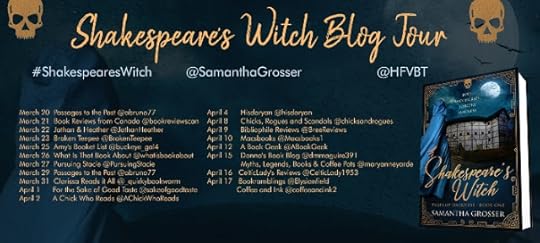
Shakespeare’s WitchBy Samantha Grosser
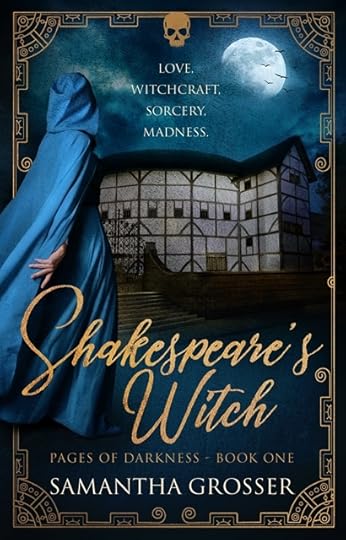
Love, Witchcraft, Sorcery, Madness.
A fortune told …
When Sarah Stone foresees Will Shakespeare’s latest play has opened doors to evil, she begs the playwright to abandon it. But Will refuses, aware the play is one of his best. And so rehearsals for Macbeth begin.
Forbidden desires …
After her vision, Sarah fears for her life – she has never known the shewstone to lie, and she turns to her brother Tom for comfort. A strange darkness seems to haunt the playhouse, and when Tom sets out to seduce John Upton, the boy actor who plays Lady Macbeth, the boy sees the hand of witchcraft in his own forbidden desires for men. Then Sarah weaves a spell to win the love of the new lead actor, and John, terrified for the safety of his soul, begins to make his accusations.
The Spirits have spoken …
As rehearsals continue, Sarah and Tom must struggle to convince John he is mistaken and that his sins are his own – their lives and the fortune of the play are at stake. But the Spirits have spoken – will the fate that Sarah foresaw come to pass or is their destiny their own to decide?
Set against the first production of Macbeth in 1606, Shakespeare’s Witch is a seductive tale of the origins of the curse of the Scottish Play. Excerpt
Inside the theatre, Will touched his torch to the others in their sconces, and the shadows bobbed and danced as the small party made their way across the broad yard and up onto the stage.
‘Here?’ Will asked Sarah’s mother.
Elizabeth nodded. It was a good place to scry– quiet and dark and open to the sky.
Sarah stepped away from the others to the edge of the stage and looked out into the empty darkness, allowing the activity behind her to ebb into the background of her thoughts. Above her the painted heavens marked the positions of the stars in hues of gold and blue, and beyond the roof that covered the stage, the night sky hovered velvet black, pinpricked with the first real stars of silver. Even in the shadows she knew every detail of the playhouse – the wide yard before the apron and the three tiers of wooden galleries that circled it, the sweep of the stage to the tiring house behind with its three floors of dressing rooms and storerooms, and at the top, the wardrobe where she worked with her brother to sew the actors’ costumes.
She was aware of it all, a place of magic even in the silent evening dark, and she allowed her breathing to soften, opening herself up to the promise of the night. Then, when she sensed that the others were ready behind her, she turned around to face them. A single candle flickered lightly on the small table they had placed centre stage, and the shewstone lay on a linen cloth before it, its surface smooth and dark and inviting. Her brother gestured to the stool he had set before it, and though she was aware of the eyes of the others watching her as she took her seat, she took time to make herself comfortable, straightening her skirts, tucking back stray hair from her face. Her own gaze never left the surface of the stone. When, finally, she was settled, her mother and brother took their places just behind her and placed a hand on her shoulders: she could feel the strength of their connection as the shewstone beckoned, insistent, demanding her attention. The candle flitted and danced at the edges of her vision, and the blackness of the stone seemed to deepen. Behind it, across the table, she saw Will take his seat, nervous hands smoothing back the thinning hair and a sheen of sweat across the unnatural pallor of his forehead. She had never known him so unnerved.
His gaze travelled to her mother. ‘Sarah will scry?’ he asked.
‘She has a greater gift than I,’ Elizabeth answered.
He gave a quick nod and Sarah lifted a small smile of reassurance towards him. But as the shewstone began to shimmer its offer of foreknowledge, the weight of the hands on her shoulders began to seem a heavier burden. With a sudden rush of apprehension, she wished he hadn’t asked for this; she sensed already she would see only pain, and sometimes it was better not to know.
‘What would you like to ask of the spirits?’ she said. Her voice sounded strong and even, no trace of the tremor of her fear.
‘I want to know,’ he replied, and his voice was equally calm, ‘if the play I am writing now will have good fortune.’
‘The name of the play?’
‘Macbeth.’
Giveaway
During the Blog Tour, we will be giving away one eBook and one paperback copy of Shakespeare’s Witch! You can enter:HERE!Giveaway Rules
• Giveaway ends at 11:59pm EST on April 17th. You must be 18 or older to enter.
• Giveaway is open to residents in the US & UK only.
• Only one entry per household.
• No sweepstakes accounts please.
• All giveaway entrants agree to be honest and not cheat the systems; any suspicion of fraud is decided upon by blog/site owner and the sponsor, and entrants may be disqualified at our discretion.
• The winner has 48 hours to claim prize or a new winner will be chosen.AMAZON US • AMAZON UK • BARNES AND NOBLE
Samantha Grosser
 Historical fiction author Samantha Grosser originally hails from England, but now lives on the sunny Northern Beaches of Sydney with her husband, son and a very small dog called Livvy.Combining a lifelong love of history with a compulsion to write that dates from childhood, Samantha is now bringing her passion for telling compelling stories to the world.Samantha has an Honours Degree in English Literature and taught English for many years in Asia and Australia. She is the author of wartime dramas Another Time and Place and The Officer’s Affair, and The King James Men, set during the turbulent early years of 17th Century.Connect with Samantha:WEBSITE • FACEBOOK • TWITTER • GOODREADS • BOOKBUB • PINTEREST • INSTAGRAM
Historical fiction author Samantha Grosser originally hails from England, but now lives on the sunny Northern Beaches of Sydney with her husband, son and a very small dog called Livvy.Combining a lifelong love of history with a compulsion to write that dates from childhood, Samantha is now bringing her passion for telling compelling stories to the world.Samantha has an Honours Degree in English Literature and taught English for many years in Asia and Australia. She is the author of wartime dramas Another Time and Place and The Officer’s Affair, and The King James Men, set during the turbulent early years of 17th Century.Connect with Samantha:WEBSITE • FACEBOOK • TWITTER • GOODREADS • BOOKBUB • PINTEREST • INSTAGRAM
Published on April 14, 2019 23:00
#HistoricalFiction author, Sarah Kennedy, is taking a look at the ups and downs of the publishing industry. There is also a chance to check out Sarah's book — The Altarpiece @KennedyNovels
The ups and downs of the publishing industry.By Sarah Kennedy
 Photo by John Jennings on Unsplash
Photo by John Jennings on UnsplashYour publisher is shutting down.
That’s not a message that any writer wants to hear, but it happened to me last year with my fiction publisher. I suspected that something was not right the morning that I received a message from Facebook that I was no longer an administrator on the publisher’s page, but, hoping that it was an error—or better yet, an upgrade!—I emailed to ask what was going on. Silence on the other end. That did not portend anything good, and, sure enough, later that day the news arrived: the publisher was closing her doors.
I’ve worked with both independent and university-affiliated publishers, both large and small, but never was the shock so great, because it was sudden and unexplained. All of the authors had had doubts about how the books were being produced and marketed, but it was a small, fairly new press, and we worked together to help out and to offer advice. But none of us expected the house to close without any attempt to bring us into the conversation.
Unsurprisingly, the emails were soon flying among the writers with questions about what had happened, where our royalties would go, and whether we would receive books that we had already paid for. Few of us got responses at all, and the responses that did come (at least to me) were vague. I don’t think that anyone ever received a royalty check or was compensated for the books they had ordered. I hope I am wrong about that.
The initial jolt soon gave way to a kind of despair. I, like many of my fellow authors, was in the middle of a series. Who would pick me up? Who would republish half of a series? The worry became overwhelming, to the point that I wondered if I would have the energy to start again.
Writing, however, is a calling that must be answered.
Weeks went by as I searched various publishers’ websites, checked out their lists, and ordered books that looked interesting. Working again with a small independent press was my goal, but I toyed briefly with the idea of going the route of self-publishing. Control over my own production and marketing appealed in some ways, but the more I explored that option, the less I thought that it was the way for me. A community of writers is as important to me as having new books, and I didn’t like the look of going it alone for long.
As I researched presses and read their books, I also began to look back at my own publications. The cover of the first novel had never seemed right to me, and at least one friend had told me outright that the image was completely wrong for the period. Another friend had mentioned, a bit wryly, that it was “very holy.” Now, my series is about the Tudor England period, and my continuing character is a former novice who grew up in a convent, so to have a religious image was a good idea. But it wasn’t the right image, and I knew that.
Then it occurred to me that taking a hiatus from the book-a-year publishing that I had been doing might in fact be a blessing in disguise. I had some time to think about the development of the series and to go back through the books and clean up infelicities. I could think about cover images and what I really wanted on the fronts of my novels.
Suddenly, my mood lifted, and the loss of a publisher began to look like an opportunity instead of a disaster. I did some editing of the first two books, not an enormous amount, but enough to improve the prose.
And then, lo! I found a new publisher, Penmore Press. They agreed to republish the first installments of the series, with new covers and my slight changes to the story. They were fast, efficient, and they produced a new cover for the first book, The Altarpiece, that I love.
Do I feel bitter? Angry? I suppose at first I did. But not any more. My first publisher took me on when I hadn’t ever published any fiction at all, let alone a novel. She did her best, I believe, to support me and to encourage me while she could, and I will always be thankful for that. I’m also thankful, in hindsight, that I was given a chance to revise my books, with the greater knowledge and experience that I now have.
And so all’s well that ends well. It really did turn out to be the best thing that could have happened to me as a novelist. Hooray for Penmore Press—onward and upward!
The Altarpiece (The Cross and The Crown Book 1)

It is 1535, and in the tumultuous years of King Henry VIII’s break from Rome, the religious houses of England are being seized by force. Twenty-year-old Catherine Havens is a foundling and the adopted daughter of the prioress of the Priory of Mount Grace in a small Yorkshire village. Catherine, like her adoptive mother, has a gift for healing, and she is widely sought and admired for her knowledge. However, the king's divorce dashes Catherine’s hopes for a place at court, and she reluctantly takes the veil. When the priory’s costly altarpiece goes missing, Catherine and her friend Ann Smith find themselves under increased suspicion. King Henry VIII’s soldiers have not had their fill of destruction, and when they return to Mount Grace to destroy the priory, Catherine must choose between the sacred calling of her past and the man who may represent her country’s future.
Amazon UK • Amazon US

Sarah KennedySarah Kennedy is the author of the novels Self-Portrait, with Ghost and The Altarpiece, City of Ladies, and The King’s Sisters, Books One, Two, and Three of The Cross and the Crown series, set in Tudor England. She has also published seven books of poems. A professor of English at Mary Baldwin University in Staunton, Virginia, Sarah Kennedy holds a PhD in Renaissance Literature and an MFA in Creative Writing. She has received grants from both the National Endowment for the Arts, the National Endowment for the Humanities, and the Virginia Commission for the Arts. Please visit Sarah at her website.
Published on April 14, 2019 22:00
Now is your chance to vote for your favourite book cover for April over on The Coffee Pot Book Club! #BookCovers #CoffeePotBookClub
The Coffee Pot Book ClubBook Cover of the Month
 Readers' Choice!April 2019
Readers' Choice!April 2019★ 1 ★The Beaufort BrideJudith Arnopp
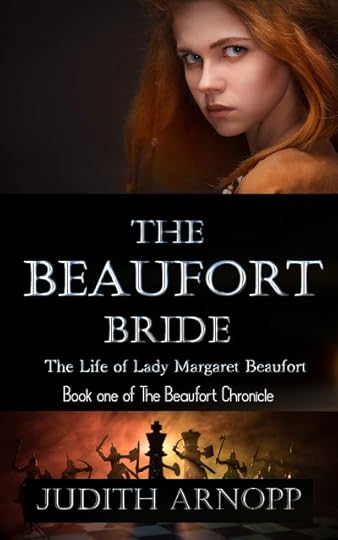
★ 2 ★A Tale of Two SistersBy Merryn Allingham

★ 3 ★
An Officer's Vow
By Penny Hampson
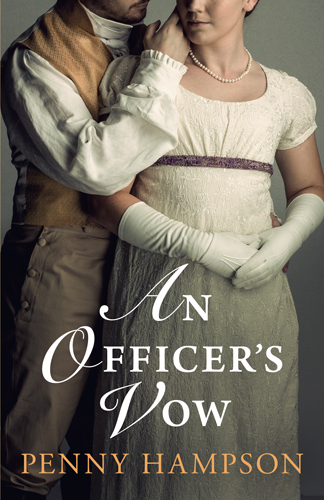
★ 4 ★The Lover's PortraitBy Jennifer S. Alderson

★ 5 ★Victoria to VikingsThe Circle of BloodBy Trisha Hughes

★ 6 ★The Lost History of DreamsBy Kris Waldherr
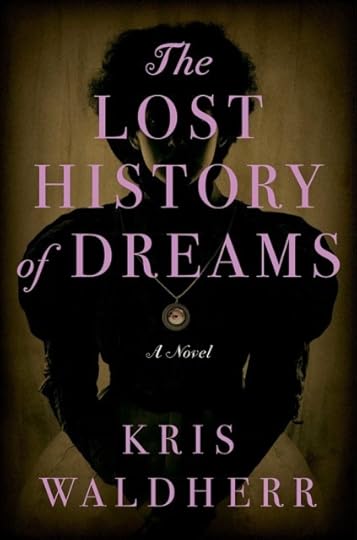
★ 7 ★The King of DunkirkBy Dominic Fielder

★ 8 ★The Swan's RoadBy Garth Pettersen
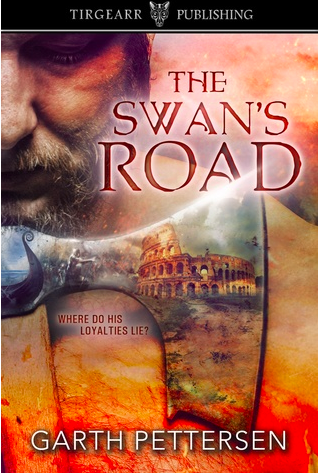
★ 9 ★A Divided Inheritance
By Deborah Swift

★ 10 ★The Girl From Oto
Amy Maroney

★ 11 ★Glass Island
By Gareth Griffith

★ 12 ★
Follow Your Heart
By Ruth Kaufman

★ 13 ★
The Breach
By Chrystyna Lucyk-Berger
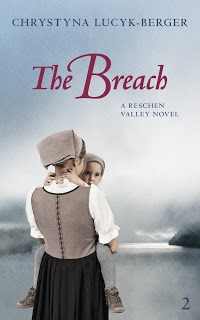
★ 14 ★
The Fourth Courier
By Timothy Jay Smith
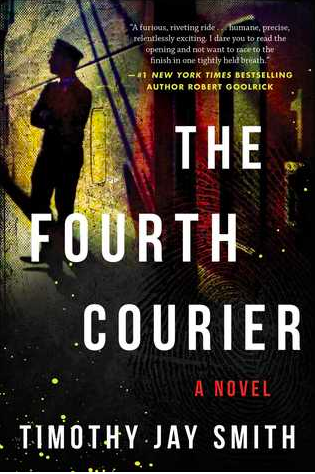
★ 15 ★
The Lady of the Tower
By Elizabeth St.John

★ 16 ★
The Briton and the Dane
By Mary Ann Bernal
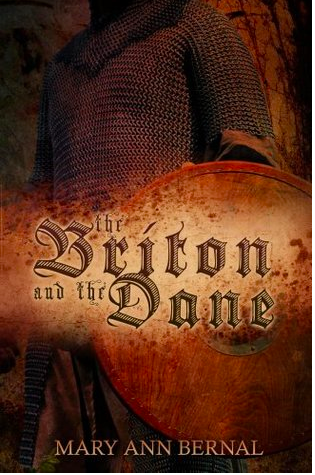
★ 17 ★
The Labyrinthine Journey
By Luciana Cavallaro

★ 18 ★
Burton Blake
By Robert Tucker
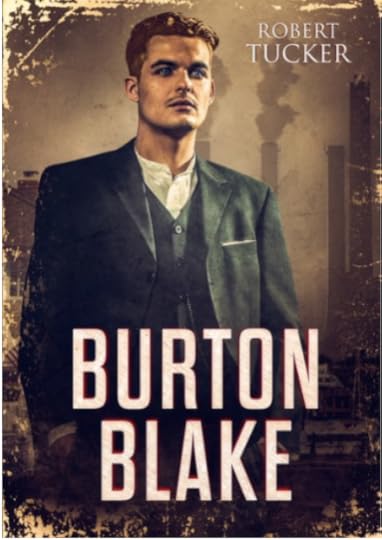
★ 19 ★
The Altarpiece
By Sarah Kennedy

★ 20 ★
Shakespeare's Witch
By Samantha Grosser

★ 21 ★
Song of Songs
By Marc Graham

★ 22 ★
The Daughters of Ironbridge
By Mollie Walton

★ 23 ★
Victus
The Civilis Saga
By Peter Baggott
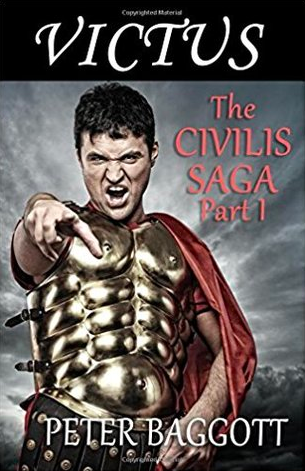
★ 24 ★
The Time Collector
By Gwendolyn Womack

★ 25 ★
Miriamne the Magdala
By JB Richards

★ 26 ★
The Highlander's Lost Lady
By Anna Campbell

★ 27 ★
Sauce for the Gander
By Jayne Davis
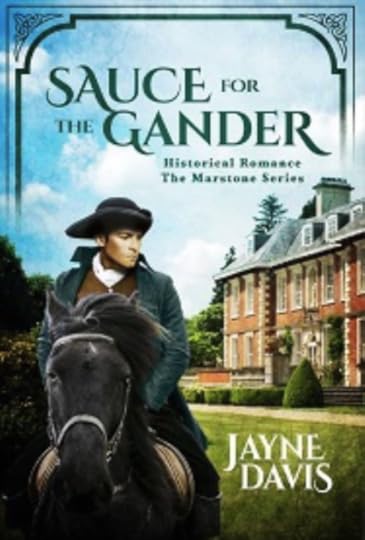
★ 28 ★
The White Rose Rent
By J.P Reedman

★ 29 ★
The Silken Rose
By Carol McGrath

★ 30 ★
Bound for Home
By Michael E Wills

★ 31 ★
Distracting the Duke
By Elizabeth Keysian

Good Luck!!
Published on April 14, 2019 20:00
April 11, 2019
Check out #HistoricalRomance author, Elizabeth Keysian, fabulous new book — Beguiling the Baron #Regency #Giveaway @EKeysian
Beguiling the Baron
By Elizabeth Keysian
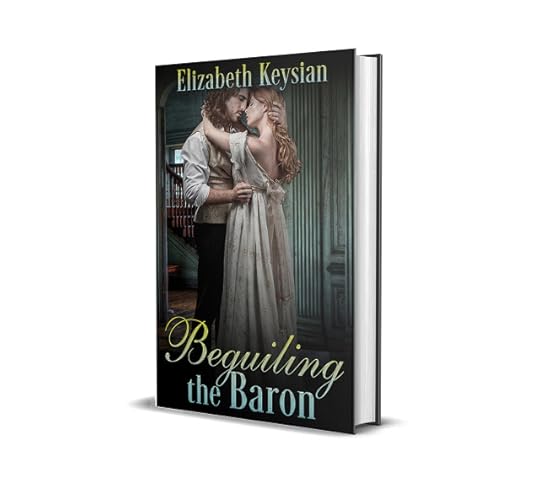
Beware reclusive barons. They are more hot-blooded than you’d expect.
A man who lurks day and night in an eerie tower must have something to hide. So thinks Galatea, governess to Lord Ansford’s love-starved young daughter. Galatea’s new employer is objectionable, stubborn, great-hearted, handsome and, curse it, well worth saving from himself.
He proves her right with some shocking physical encounters, adding tinder to the blaze of her growing love for him. But just as the barriers between them are crumbling away, the tower crashes down.
With Lord Ansford inside it.
Excerpt
“Good God, what’s digging needles into my leg?” Lord Ansford jumped up in alarm as a small, dark object propelled itself from his lap to the ham on his plate. With impressive speed, he seized the silver cover from the sideboard and clamped it down on top of Polly’s kitten, which mewed its resentment.
“What,” he inquired in icy tones, “is this?”
Seeing his furious face but also aware of the sounds of feline eating coming from beneath the cover, hysteria threatened. “I fear it is Polly’s kitten,” Tia gasped.
An aristocratic eyebrow arched upward. “Indeed? Aldergate!”
At the footman’s almost immediate appearance, her amusement was doused by a wash of fear. What did the furious aristocrat plan to do with Polly’s pet?
Ansford handed both plate and cover to the bemused servant. “There is a live animal beneath here. Deal with it, if you please.”
Tia watched in horror as the hapless creature was whisked out of the breakfast room. She turned anxiously to Ansford, who was glowering at the unwelcome interruption to his breakfast.
She couldn’t bear it. “You won’t kill it? Please, my lord, don’t. It has given Polly such pleasure.”
The look he turned on her froze her to the marrow. With the briefest of nods, he turned his back on both her and Mama and stalked out of the room.
A lofty silence descended. Eventually, Mama exclaimed, “Well, I never!”
“I thought he was improving. But I was wrong—the baron’s as hard-hearted and rude as ever.” Tia’s temper rose.
Mama shot her a worried look. “What do you think he’ll do?”
“I’d like to say he’ll eventually see the humor in the situation, but I fear Ansford would choke and suffocate if he attempted to laugh, he’s so unused to it. He’ll probably have the kitten drowned.”
“Oh no, you don’t think so? Polly will be devastated.”
Of course, she would. Tia would be too. “I don’t believe Lord Ansford understands about tender feelings.” She heaved a heartfelt sigh. “His own died with his wife.”
“I hope you’re mistaken, but he seemed excessively angry with us. Do you think he’s a bit peculiar in the head?”
“That wouldn’t surprise me at all. Now, I’d best hurry up and see how many French verbs I can get Polly to conjugate before she learns of her kitten’s demise. When that news reaches her, we’ll have to abandon the curriculum for at least a week.”
Unless, of course, she was brave enough to tackle Lord Ansford. Again.
But in his present mood, how could she do so without risking the fate of all those she cared about?
Giveaway
Elizabeth Keysian is giving away one ebook copy of
“Beguiling the Baron.”
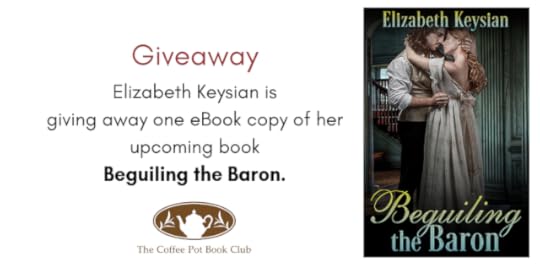
All you need to do is answer this question:
“What do you think Lord Ansford will ultimately
do with the kitten?”
Leave your answer in the comments at the bottom of this post.
Giveaway Rules
• Leave your answer in the comments at the bottom of this post.
• Giveaway ends at 11:59pm BST on April 25th.
You must be 18 or older to enter.
• Giveaway is only open Internationally.
• Only one entry per household.
• All giveaway entrants agree to be honest and not cheat the systems; any suspect of fraud is decided upon by blog/site owner and the sponsor, and entrants may be disqualified at our discretion.
•Winners will be announced in the comments.
• Winner has 48 hours to claim prize or new winner is chosen.
Pre-order your copy of
Beguiling the Baron
Released April 17th.
Amazon UK • Amazon US •
Amazon AU • Amazon CA
Read for FREE on

Elizabeth Keysian
 Bestselling author Elizabeth Keysian adores history and archaeology, and writes romances that give the reader an experience of travelling back in time.
Bestselling author Elizabeth Keysian adores history and archaeology, and writes romances that give the reader an experience of travelling back in time.She feels very British-despite her Viking ancestry-and loves creating rich backdrops for her stories based on real places and actual experiences. She used to be a re-enactor, so has sampled the living conditions, clothing, and smells of the past. She’s also sampled the food, which was actually pretty good.
Her characters battle their problems with both tears and laughter, but she always guarantees them a Happily Ever After, no matter what she’s put them through.
Subscribers to Elizabeth’s Key to Romance newsletter have access to exclusive content, contests and advance notice of bargains and freebie books: Newsletter Signup.
Elizabeth is a founder member of A Touch of Intrigue – a Gathering of Authors and Readers of Historical Romance. They have the best Facebook parties EVER. Please join up:HERE!
You can find Elizabeth on Facebook • Twitter • Pinterest.
Published on April 11, 2019 23:00
Have you heard? #HistoricalFiction author, Robert Tucker, is giving away 3 eBook copies of his fabulous book — Burton Blake @HFVBT
Historical Fiction Virtual Blog Tours Presents…

Burton BlakeBy Robert Tucker
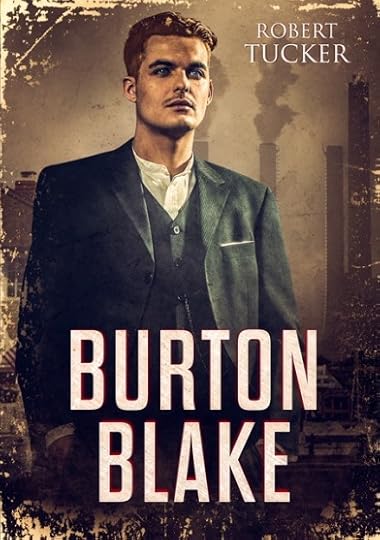
In this sequel to The Revolutionist, the American journey of three generations locks the neophyte company president, Burton Blake, in a vicious struggle with corporate intrigue, financial greed, and social corruption.Born to a taxi dancer at the beginning of the Second World War, Burton’s father, Elias Blake, never knows his natural father, who is killed in the South Pacific. He is raised by his mother and stepfather from her second marriage who makes his fortune during the post war real estate boom of the 50’s. Their untimely death by his business partner leaves the boy Elias in the guardianship of his mother’s best friend and her marine vet husband who introduces him to the macho culture of guns and hunting.Elias’s youth is influenced by the adult world’s drive for personal material gain. Over the next decades, he expands his parents’ original real estate empire into the diversified multi-divisional, multi-national corporation that he leaves to his son, Burton.
Upon his forced return from traveling and working with oppressed third world people, Burton learns increasingly more about the true nature of his deceased father as he undertakes the challenges of leading the company in a new direction.
Giveaway
During the Blog Tour, we will be giving away three eBooks of Burton Blake! EnterHERE!Giveaway Rules
• Giveaway ends at 11:59pm EST on April 26th. You must be 18 or older to enter.• Giveaway is open INTERNATIONALLY.• Only one entry per household.• No sweepstakes accounts please.• All giveaway entrants agree to be honest and not cheat the systems; any suspicion of fraud is decided upon by blog/site owner and the sponsor, and entrants may be disqualified at our discretion.• The winner has 48 hours to claim prize or a new winner will be chosen.
Pick up your copy ofBurton BlakeAMAZON | BARNES AND NOBLE
Robert Tucker
 Rob is a graduate of the University of California, Santa Barbara and received his graduate degree in communications from the University of California, Los Angeles.Rob worked as a business and management consultant to advertising, corporate communications, and media production companies as well as many others. Now retired, he resides with his wife in Southern California where he devotes much of his time to writing.He is a recipient of the Samuel Goldwyn and Donald Davis Literary Awards. An affinity for family and the astute observation of generational interaction pervade his novels.His works are literary and genre upmarket fiction that address the nature and importance of personal integrity.For more information, please visit Robert Tucker’s website. You can also find him on Facebook, Twitter, and Goodreads.
Rob is a graduate of the University of California, Santa Barbara and received his graduate degree in communications from the University of California, Los Angeles.Rob worked as a business and management consultant to advertising, corporate communications, and media production companies as well as many others. Now retired, he resides with his wife in Southern California where he devotes much of his time to writing.He is a recipient of the Samuel Goldwyn and Donald Davis Literary Awards. An affinity for family and the astute observation of generational interaction pervade his novels.His works are literary and genre upmarket fiction that address the nature and importance of personal integrity.For more information, please visit Robert Tucker’s website. You can also find him on Facebook, Twitter, and Goodreads.
Published on April 11, 2019 22:00
The Coffee Pot Book Club
The Coffee Pot Book Club (formally Myths, Legends, Books, and Coffee Pots) was founded in 2015. Our goal was to create a platform that would help Historical Fiction, Historical Romance and Historical
The Coffee Pot Book Club (formally Myths, Legends, Books, and Coffee Pots) was founded in 2015. Our goal was to create a platform that would help Historical Fiction, Historical Romance and Historical Fantasy authors promote their books and find that sometimes elusive audience. The Coffee Pot Book Club soon became the place for readers to meet new authors (both traditionally published and independently) and discover their fabulous books.
...more
...more
- Mary Anne Yarde's profile
- 159 followers



